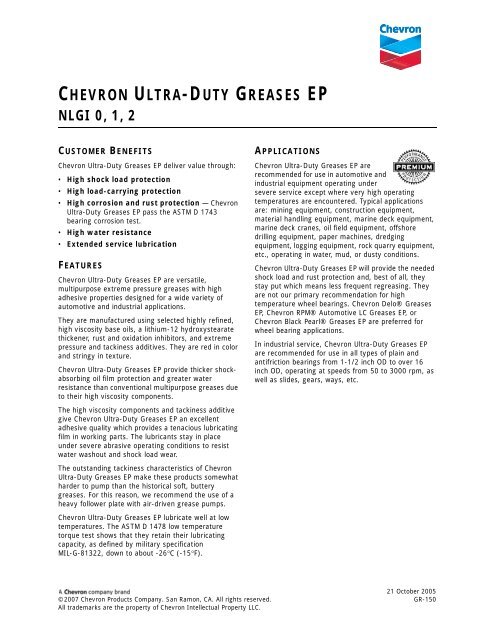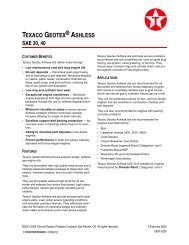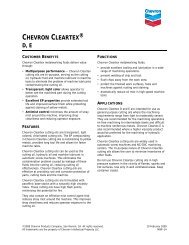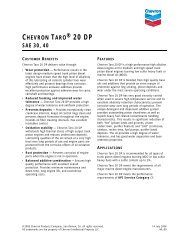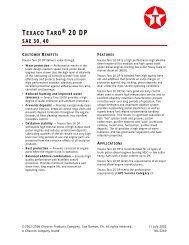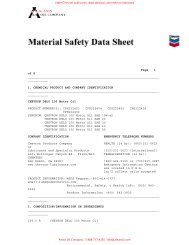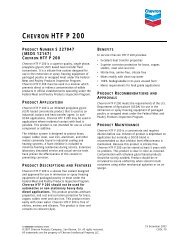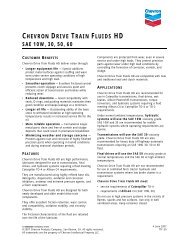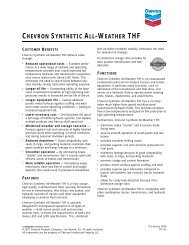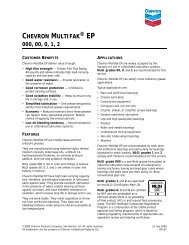chevron ultra-duty greases ep nlgi 0, 1 - Alexis Oil
chevron ultra-duty greases ep nlgi 0, 1 - Alexis Oil
chevron ultra-duty greases ep nlgi 0, 1 - Alexis Oil
Create successful ePaper yourself
Turn your PDF publications into a flip-book with our unique Google optimized e-Paper software.
CHEVRON ULTRA-DUTY GREASES EP<br />
NLGI 0, 1, 2<br />
CUSTOMER BENEFITS<br />
Chevron Ultra-Duty Greases EP deliver value through:<br />
• High shock load protection<br />
• High load-carrying protection<br />
• High corrosion and rust protection — Chevron<br />
Ultra-Duty Greases EP pass the ASTM D 1743<br />
bearing corrosion test.<br />
• High water resistance<br />
• Extended service lubrication<br />
FEATURES<br />
Chevron Ultra-Duty Greases EP are versatile,<br />
multipurpose extreme pressure <strong>greases</strong> with high<br />
adhesive properties designed for a wide variety of<br />
automotive and industrial applications.<br />
They are manufactured using selected highly refined,<br />
high viscosity base oils, a lithium-12 hydroxystearate<br />
thickener, rust and oxidation inhibitors, and extreme<br />
pressure and tackiness additives. They are red in color<br />
and stringy in texture.<br />
Chevron Ultra-Duty Greases EP provide thicker shockabsorbing<br />
oil film protection and greater water<br />
resistance than conventional multipurpose <strong>greases</strong> due<br />
to their high viscosity components.<br />
The high viscosity components and tackiness additive<br />
give Chevron Ultra-Duty Greases EP an excellent<br />
adhesive quality which provides a tenacious lubricating<br />
film in working parts. The lubricants stay in place<br />
under severe abrasive operating conditions to resist<br />
water washout and shock load wear.<br />
The outstanding tackiness characteristics of Chevron<br />
Ultra-Duty Greases EP make these products somewhat<br />
harder to pump than the historical soft, buttery<br />
<strong>greases</strong>. For this reason, we recommend the use of a<br />
heavy follower plate with air-driven grease pumps.<br />
Chevron Ultra-Duty Greases EP lubricate well at low<br />
temperatures. The ASTM D 1478 low temperature<br />
torque test shows that they retain their lubricating<br />
capacity, as defined by military specification<br />
MIL-G-81322, down to about -26°C (-15°F).<br />
APPLICATIONS<br />
Chevron Ultra-Duty Greases EP are<br />
recommended for use in automotive and<br />
industrial equipment operating under<br />
severe service exc<strong>ep</strong>t where very high operating<br />
temperatures are encountered. Typical applications<br />
are: mining equipment, construction equipment,<br />
material handling equipment, marine deck equipment,<br />
marine deck cranes, oil field equipment, offshore<br />
drilling equipment, paper machines, dredging<br />
equipment, logging equipment, rock quarry equipment,<br />
etc., operating in water, mud, or dusty conditions.<br />
Chevron Ultra-Duty Greases EP will provide the needed<br />
shock load and rust protection and, best of all, they<br />
stay put which means less frequent regreasing. They<br />
are not our primary recommendation for high<br />
temperature wheel bearings. Chevron Delo® Greases<br />
EP, Chevron RPM® Automotive LC Greases EP, or<br />
Chevron Black Pearl® Greases EP are preferred for<br />
wheel bearing applications.<br />
In industrial service, Chevron Ultra-Duty Greases EP<br />
are recommended for use in all types of plain and<br />
antifriction bearings from 1-1/2 inch OD to over 16<br />
inch OD, operating at speeds from 50 to 3000 rpm, as<br />
well as slides, gears, ways, etc.<br />
21 October 2005<br />
©2007 Chevron Products Company. San Ramon, CA. All rights reserved. GR-150<br />
All trademarks are the property of Chevron Intellectual Property LLC.
Chevron Ultra-Duty Greases EP — Continued<br />
TYPICAL TEST DATA<br />
NLGI Grade 0 1 2<br />
Product Number 238013 238012 238011<br />
MSDS Number<br />
Operating Temperature,°C(°F)<br />
6790 6790 6790<br />
Minimum1 Maximum2 -26(-15) -26(-15) -26(-15)<br />
132(270) 138(280) 143(290)<br />
Penetration, (Worked 60 Strokes) at 25°C (77°F) 370 325 280<br />
Dropping Point,°C(°F) 172(342) 172(342) 190(374)<br />
Four Ball Weld Point, kg 315 315 315<br />
Four Ball Wear Scar, mm 0.45 0.45 0.45<br />
Timken OK Load, lb 55 70 70<br />
Water Washout, wt% 15 10 7<br />
Water Spray-off, wt%<br />
Lincoln Ventmeter, psig at 30 s, at<br />
n/a 40 25<br />
75°F<br />
100<br />
100<br />
280<br />
30°F<br />
200<br />
400<br />
600<br />
0°F<br />
1700<br />
1750<br />
2500<br />
Thickener, %<br />
5.6<br />
7.2<br />
8.6<br />
Type<br />
Lithium<br />
Lithium<br />
Lithium<br />
ISO Viscosity Grade,Base <strong>Oil</strong> Equivalent<br />
Viscosity, Kinematic*<br />
460 460 460<br />
cSt at 40°C<br />
400<br />
400<br />
400<br />
cSt at 100°C<br />
Viscosity, Saybolt*<br />
24.3<br />
24.3<br />
24.3<br />
SUS at 100°F<br />
2160<br />
2160<br />
2160<br />
SUS at 210°F<br />
121<br />
121<br />
121<br />
Viscosity Index* 76 76 76<br />
Flash Point, °C(°F)* 274(525) 274(525) 274(525)<br />
<strong>Oil</strong> S<strong>ep</strong>aration, mass % 5 4 2<br />
Texture Stringy Stringy Stringy<br />
Color Red Red Red<br />
Typical test data are average values only. Minor variations which do not affect product performance are to be expected in normal<br />
manufacturing.<br />
1 Minimum operating temperature is the lowest temperature at which a grease, already in place, could be expected to<br />
provide lubrication. Most <strong>greases</strong> cannot be pumped at these minimum temperatures.<br />
2 Maximum operating temperature is the highest temperature at which the grease could be used with frequent (daily)<br />
relubrication.<br />
* Determined on mineral oil extracted by vacuum filtration.<br />
©2007 Chevron Products Company. San Ramon, CA. All rights reserved. 21 October 2005<br />
GR-150


